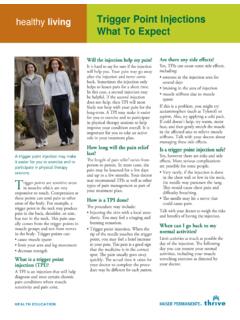Transcription of Fiber Facts: Why fiber is important - Kaiser Permanente
1 HEALTH EDUCATIONWhy is Fiber important ?Including Fiber in your diet is good for your health in lots of ways. It can: Reduce the risk of heart disease and type 2 diabetes. Lower the risk of several forms of cancer. Improve cholesterol and blood pressure. Help regulate your digestion. Help you feel fuller, so you may eat is Fiber ? Fiber is the part of plant foods that our bodies can t digest or absorb. It is found in fruits, vegetables, beans, peas, lentils, nuts, seeds, and whole are 2 kinds of dietary Fiber : insoluble and soluble. We benefit from Fiber comes from fruit, some vegetables, oats, beans, peas, lentils, and barley,. When mixed with liquid, it forms a gel, which helps control blood sugar and reduces cholesterol. Insoluble Fiber comes from fruits, grains, and vegetables. It adds bulk and acts like a brush to clean out the colon. It helps food pass through the digestive tract more quickly and prevents constipation .
2 What is a whole grain?A whole grain has all three of its original parts: The bran ( Fiber -rich outer layer). The endosperm (middle layer). The germ (inner layer). Whole grains are rich in nutrients, including Fiber . Whole wheat, oatmeal, rye, cornmeal, bulgur, barley, brown rice, and even popcorn are all whole refined grain has been milled, so only the middle layer (endosperm) is left. Milling removes much of the vitamins. Enriched flour has had some of the nutrients added back, but not the Fiber . How much Fiber do I need?The American Heart Association recommends between 25 and 38 grams of Fiber a day in a well-balanced diet. Since most people only consume about half that amount of Fiber , try these suggestions to increase the Fiber in your more Fiber to your diet Eat at least 5 servings of fruits and vegetables every day. Try more recipes with beans, peas, barley, lentils, quinoa, bulgur, or brown rice. Choose breads, cereals, tortillas, and crackers that list a whole grain as the first ingredient on the label.
3 Make at least half of your grain servings whole grains. Add Fiber to your diet slowly, over 2 to 3 weeks. If you add it too fast, you may feel bloated or have gas pains. Unless your doctor has told you not to, drink 6 to 8 cups of water and other fluids a day to aid digestion. If you eat wheat bran to keep your bowels moving, start with 1 teaspoon per meal. Increase slowly to 2 to 4 tablespoons a day. If you use psyillium Fiber supplements, be sure to follow the directions and drink enough fluids to remain hydrated. Buy unprocessed foods when you can. Food processing often removes Fiber . Read food labelsLook for the dietary Fiber content on food labels. Good sources of Fiber have at least 10% of the percent daily value for Fiber . To find whole-grain foods, look for the words whole wheat or whole grain in the ingredient list. Multigrain, wheat, and enriched flour do not mean whole grain. If you are eating gluten-free foods, be sure to check the label for Fiber Facts: Why Fiber is importantNutrition FactsServing Size 2/3 cup (55g)Calories 230% Daily Value*Trans Fat 0gSaturated Fat 1gSugars 1gCholesterol 0mgSodium 160mgTotal Carbohydrate 37gProtein 3g10%Calcium45%12%Amount Per ServingDietary Fiber 4g* Percent Daily Values are based on a 2,000 calorie daily value may be higher or lower depending on your calorie needs.
4 IronServings Per Container About 8 Calories from Fat 72 Total Fat 8g5%0%7%12%16%Vitamin AVitamin C8%20% Calories: 2,000 2,500 Total Fat Less than 65g 80gSat Fat Less than 20g 25gCholesterol Less than 300mg 300mgSodium Less than 2,400mg 2,400mgTotal Carbohydrate 300g 375gDietary Fiber 25g 30g10%5%0%7%13%14%10%20%45%6%20%160mg8gN utrition Facts Calories 230 Amount per serving Total Fat Saturated Fat 1g Trans Fat 0gCholesterol 0mgSodium Total Carbohydrate 37gDietary Fiber 4g Total Sugars 12g Includes 10g Added Sugars Protein 3gVitamin D 2mcgCalcium 260mg Iron 8mgPotassium 235mg % Daily Value*The % Daily Value (DV) tells you how much a nutrient in a serving of food contributes to a daily diet. 2,000 calories a day is used for general nutrition servings per containerServing size 2/3 cup (55g)*Note: The images above are meant for illustrative purposes to show how the new Nutrition Facts label might look compared to the old label.
5 Both labels represent fictional products. When the original hypothetical label was developed in 2014 (the image on the left-hand side), added sugars was not yet proposed so the original label shows 1g of sugar as an example. The image created for the new label (shown on the right-hand side) lists 12g total sugar and 10g added sugar to give an example of how added sugars would be broken out with a % Daily information is not intended to diagnose health problems or to take the place of medical advice or care you receive from your physician or other health care professional. If you have persistent health problems, or if you have additional questions, please consult with your doctor. If you have questions or need more information about your medication, please speak to your pharmacist. 2006, The Permanente Medical Group, Inc. All rights reserved. Regional Health Education. 90346 (Revised 10/16) RL Content of FoodsVegetablesServingSizeDietaryFiber (g)Artichoke hearts, cooked cup5g* Asparagus, cooked cup2g* Avocado cup6gBaked potato with skin 1 medium4gBeets cup2gBroccoli, cooked cup3g* Brussel sprouts cup3gCabbage, cooked cup1gCarrots, raw1 medium2gCauliflower, cooked cup1gChinese mustard greens cup2gCorn, cooked cup2gEggplant, cooked cup2gFennel, raw/sliced cup1gGreen beans, cooked cup2gLettuce, Romaine2 cups 2gOnions, chopped cup1gPeas, cooked cup4gSpinach, cooked cup4g* Sweet potato, cooked cup 4gSwiss chard, cooked cup2gTomato, raw1 medium2gTurnips, cooked cup2gZucchini, sliced cup <1gBeans and NutsServing sizeDietary Fiber (g)
6 Almonds cup4g* Black beans, cooked cup8gFlaxseed, ground 2 tbs4g* Kidney beans cup8gLentils, cooked cup8g* Lima beans, cooked cup7g* Navy beans, cooked cup10g* Peanuts cup3gPecans, chopped cup3g* Pinto beans, cooked cup8gPistachios cup3g* Soy beans (Edamame) cup5gFruitsServingSizeDietary Fiber (g)Apple, with peel1 medium3g* Apricots1 medium1gAsian pear1 medium4gBanana1 medium3gCantaloupe cup1gCherries10 medium1gFigs, raw1 medium1gHoneydew cup2g* Mango1 medium4gNectarine1 medium2g* Orange1 medium3gPapaya cup1gPeach, with skin1 medium2gPear, with skin1 medium5g* Prunes cup6gRaisins cup3gRaspberries cup4gStrawberries, sliced cup2gCerealServingSizeDietaryFiber (g)All Bran (100%) cereal cup9gCheerios1 cup4gGranola1 cup3gFiber One cup 14gRaisin Bran1 cup7gShredded Wheat1 cup6gWheat bran2 tbs3gWheaties1 cup3gGrainsServingSizeDietaryFiber (g)* Barley, cooked1 cup6gBrown rice, cooked1 cup4gRice noodles1 cup2gQuinoa, cooked1 cup5gRye bread 1 slice2gWhole-wheat bread1 slice3gWhole-wheat english muffin 1 slice3gWhole-wheat pasta, cooked1 cup4g* High in soluble Fiber .
7 Source: USDA National Nutrient Database for Standard resourcesVisit your doctor s home page at Contact your Kaiser Permanente Health Education Center or Department for health information, programs, and other resources.









